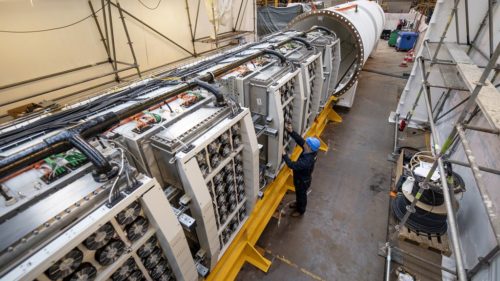Orkney Islands, Scotland —(Map)
The computer company Microsoft recently ended an unusual experiment by pulling up a data center that has been serving internet requests from under the sea for the last two years. The company says the experiment was a success.

(Source: Jonathan Banks, Microsoft.)
Data centers are usually large buildings full of hundreds or thousands of high-powered computers called servers. You may not think about data centers much, but they’re responsible for everything that we do on the Internet.
When we search for something, or load a webpage, our requests follow a bouncing path through the internet until they reach one or many servers, which give us back the information we asked for. As the internet has grown, the need for data centers has also grown.

(Source: Florian Hirzinger – www.fh-ap.com [CC BY-SA], via Wikimedia Commons.)
Data centers have many problems. The servers use huge amounts of energy. Some of this is needed to make the computers run, but much of the energy is used to keep the servers cool. If computers overheat, they’re far more likely to break.
Microsoft wanted to try putting a data center under the sea, to see if the seawater could naturally cool the computers, saving energy and money.

(Source: Frank Betermin, Microsoft.)
So the company created a special data center that could fit inside a large tank. Microsoft hired a company that builds submarines to design the tank. They wanted the unit to be large enough to hold lots of computers, but small enough to move around on a truck.
In 2018, the company lowered their data center into the water near the Orkney Islands. The data center was called “Northern Isles”, since it was located in Scotland’s northern islands.

(Source: Scott Eklund/Red Box Pictures, Microsoft.)
The air in the tank was replaced with a gas called nitrogen, to keep oxygen from damaging the computer parts. Special cables provided a high-speed internet connection and electricity. The electricity came from nearby wind and solar energy sources.
After a few tests, the Northern Isles data center was put to work. For the last two years, its 864 servers have been helping the internet run. Earlier this year, some of the servers were used to do research on the coronavirus.

(Source: Scott Eklund/Red Box Pictures, Microsoft.)
In July, the company pulled the data center back to the surface. It was covered with a thin coat of algae, and had some small sea animals clinging to it. But other than that, it was fine.
So how did the data center do? Very well, it turns out. Northern Isles used far less energy than a land-based data center would have used over the same amount of time.

(Source: Jonathan Banks, Microsoft.)
The conditions were good for the computers, too. Microsoft says that the number of servers that normally have problems on land is eight times higher than the number of servers that broke underwater.
The company says that’s probably because there wasn’t any oxygen in the container. It also helped that there were no humans near the servers, so the machines and their cables never got bumped by accident.

(Source: Jonathan Banks, Microsoft.)
Microsoft is excited about the results produced by its underwater data center, and is eager to apply the lessons they learned to other data centers in the future.
😕
This map has not been loaded because of your cookie choices. To view the content, you can accept 'Non-necessary' cookies.
